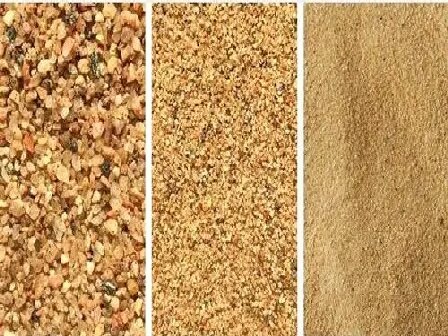Sand and redispersible polymer powder requirement in bonding mortar /Tile adhesives
FOR SAND:
One:Roundness requirement:
River sand can produce high-quality dry-mixed mortar due to its smooth surface and mostly spherical characteristics. Although the roundness of machine-made sand is relatively poor, it can meet the requirements of dry-mixed mortar by controlling the content of flake particles not to exceed 12%.
Two:Fineness modulus and gradation requirements:
The fineness modulus of machine-made sand is generally controlled between 2.3 and 2.8 to improve the strength and fluidity of dry mixed mortar, meanwhile reducing the amount of cementitious material, improving the quality of dry mixed mortar and reducing production costs. The improvement of gradation is crucial to improving the performance of mortar.
Three:Content of powder requirement:
The content of stone powder generated in the production process of machine-made sand is generally controlled between 20-25%. For specific dry-mixed mortar projects, such as plastering mortar, the content of stone powder generally needs to be controlled within 10%, while the content of stone powder in masonry mortar can be appropriately higher.
Four:Content of mud requirement:
In order to ensure the performance of tile adhesive /bonding mortar, there are strict restrictions on the content of mud in sand. For cement based dry mixed mortar and cement based mortar with a strength grade not less than M5, the content of mud should not exceed 5%; for cement mixed mortar with a strength grade less than M5, the content of mud should not exceed 10%.
FIVE:Particle size requirement of sand:
Sand can generally be divided into four types: extra-fine sand, fine sand, medium sand and coarse sand. Medium sand (particle size is 0.35-0.5mm) is suitable for home decoration and is suitable for the use of bonding mortar.
To sum up, the particle requirements of sand in bonding mortar /tile adhesives cover many aspects such as roundness, fineness modulus and gradation, content of powder and content of mud, ensuring the performance and quality of the mortar.
For redispersible polymer powder
One:As an additive to mortar, puyang ruidaxu new materials company ltd redispersible polymer powder based material can significantly improve the bonding force between the mortar and the base material. This is because VAE has good film-forming and adhesive properties and can form a strong polymer film during the curing process of the mortar, thereby enhancing the adhesion of the mortar.
When cement is mixed with VAE (ethylene-vinyl acetate copolymer emulsion), it combines the advantages of inorganic materials and organic materials to form a composite material with special properties. VAE emulsion in Portland Cement can significantly improve the bonding strength of the cement, especially when dealing with smooth surfaces or porous substrates. Because VAE emulsion is flexible, it can reduce cracks generated during cement curing, thereby improving overall crack resistance. VAE emulsion can improve the penetration resistance of cement, allowing it to perform better in humid environments.
Two:
The workability of the mixture is improved, the operation is more convenient, and the construction efficiency is improved.
Three:
High-alumina cement (Calcium Aluminate Cement) itself has fast-hardening properties. After adding VAE emulsion, it can still maintain its rapid-hardening properties while improving flexibility and crack resistance. High alumina cement has good high temperature resistance, and when combined with VAE emulsion, it can be used in some applications with high high temperature resistance requirements.
The rapid hardening properties of Calcium Sulfoaluminate Cement combined with VAE can improve crack resistance and water resistance while maintaining rapid hardening. The shrinkage rate of sulfoaluminate cement itself is low, and the addition of VAE emulsion can further reduce the shrinkage rate and improve dimensional stability.
Four:
Blended Cement is a type of cement with improved comprehensive properties. It usually contains a variety of inorganic components, such as fly ash, slag, etc. When mixed with VAE emulsion, the comprehensive performance can be further enhanced, especially in terms of adhesion, crack resistance and water resistance. The addition of VAE emulsion can significantly improve the bonding and adhesion between cement mortar or concrete and the substrate. The elasticity of VAE emulsion makes cement materials less likely to crack under stress, improving the material’s crack resistance and flexibility. VAE emulsion can reduce the water absorption of cement materials, improve their water resistance, and is suitable for humid environments. The mixture’s improved abrasion resistance makes it suitable for use as a floor or surface coating where wear resistance is required. The workability of the mixture is improved and operation is smoother, making it suitable for applications such as self-leveling floors and tile adhesives that require good workability.
By mixing different types of cement with VAE organic matter, the comprehensive performance of cement-based materials can be significantly improved to meet the needs of various engineering applications.
Some types of cement commonly used in the Middle East and their applications:
Five:
Ordinary Portland Cement (OPC) Ordinary Portland cement is the most commonly used type of cement and is widely used in various construction projects, such as residential buildings, commercial buildings, highways, bridges, etc. High strength and rapid early strength development make it suitable for most conventional construction applications.
Sulfate-Resistant Cement (SRC) Since the groundwater and soil in some places in the Middle East contain high concentrations of sulfate, this cement is particularly suitable for buildings that need to resist sulfate erosion, such as underground structures and foundations. Facilities, ports and coastal engineering. It has strong resistance to sulfate corrosion and can prevent the steel bars in concrete from being corroded.
Six
Blast furnace slag cement (Ground Granulated Blast-Furnace Slag Cement, GGBFS) is widely used in high-temperature environments, marine engineering and mass concrete projects.
Seven
Features: This cement has good durability and resistance to chemical attack, and generates low heat during the hydration process, making it suitable for use in high-temperature environments.


